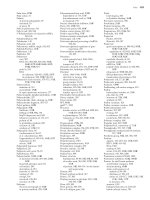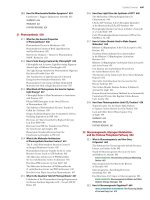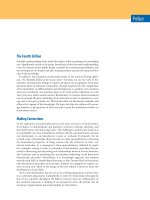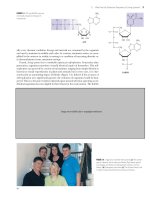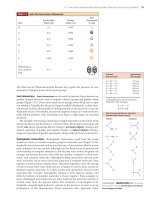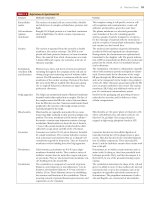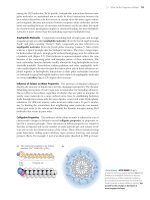Biochemistry, 4th Edition P3 docx
Bạn đang xem bản rút gọn của tài liệu. Xem và tải ngay bản đầy đủ của tài liệu tại đây (311.34 KB, 10 trang )
Detailed Contents xvii
20.8 How Do Mitochondria Mediate Apoptosis? 624
Cytochrome c Triggers Apoptosome Assembly 625
SUMMARY 626
PROBLEMS 627
FURTHER READING 628
21 Photosynthesis 630
21.1 What Are the General Properties
of Photosynthesis? 630
Photosynthesis Occurs in Membranes 630
Photosynthesis Consists of Both Light Reactions
and Dark Reactions 632
Water Is the Ultimate e
Ϫ
Donor for Photosynthetic
NADP
ϩ
Reduction 633
21.2 How Is Solar Energy Captured by Chlorophyll? 633
Chlorophylls and Accessory Light-Harvesting Pigments
Absorb Light of Different Wavelengths 634
The Light Energy Absorbed by Photosynthetic Pigments
Has Several Possible Fates 634
The Transduction of Light Energy into Chemical
Energy Involves Oxidation–Reduction 636
Photosynthetic Units Consist of Many Chlorophyll
Molecules but Only a Single Reaction Center 637
21.3 What Kinds of Photosystems Are Used to Capture
Light Energy? 637
Chlorophyll Exists in Plant Membranes in Association
with Proteins 637
PSI and PSII Participate in the Overall Process
of Photosynthesis 638
The Pathway of Photosynthetic Electron Transfer Is
Called the Z Scheme 638
Oxygen Evolution Requires the Accumulation of Four
Oxidizing Equivalents in PSII 640
Electrons Are Taken from H
2
O to Replace Electrons
Lost from P680 640
Electrons from PSII Are Transferred to PSI via
the Cytochrome b
6
f Complex 640
Plastocyanin Transfers Electrons from the
Cytochrome b
6
f Complex to PSI 641
21.4 What Is the Molecular Architecture
of Photosynthetic Reaction Centers? 641
The R. viridis Photosynthetic Reaction Center Is
an Integral Membrane Protein 642
Photosynthetic Electron Transfer by the R. viridis
Reaction Center Leads to ATP Synthesis 642
The Molecular Architecture of PSII Resembles
the R. viridis Reaction Center Architecture 643
How Does PSII Generate O
2
from H
2
O? 645
The Molecular Architecture of PSI Resembles the
R. viridis Reaction Center and PSII Architecture 645
How Do Green Plants Carry Out Photosynthesis? 647
21.5 What Is the Quantum Yield of Photosynthesis? 647
Calculation of the Photosynthetic Energy Requirements
for Hexose Synthesis Depends on H
ϩ
/h and ATP/H
ϩ
Ratios 647
21.6 How Does Light Drive the Synthesis of ATP? 648
The Mechanism of Photophosphorylation Is
Chemiosmotic 648
CF
1
CF
0
–ATP Synthase Is the Chloroplast Equivalent
of the Mitochondrial F
1
F
0
–ATP Synthase 648
Photophosphorylation Can Occur in Either a Noncyclic
or a Cyclic Mode 649
Cyclic Photophosphorylation Generates ATP but Not
NADPH or O
2
649
21.7 How Is Carbon Dioxide Used to Make Organic
Molecules? 650
Ribulose-1,5-Bisphosphate Is the CO
2
Acceptor in CO
2
Fixation 651
2-Carboxy-3-Keto-Arabinitol Is an Intermediate
in the Ribulose-1,5-Bisphosphate Carboxylase
Reaction 651
Ribulose-1,5-Bisphosphate Carboxylase Exists in Inactive
and Active Forms 651
CO
2
Fixation into Carbohydrate Proceeds Via
the Calvin–Benson Cycle 652
The Enzymes of the Calvin Cycle Serve Three Metabolic
Purposes 652
The Calvin Cycle Reactions Can Account for Net
Hexose Synthesis 653
The Carbon Dioxide Fixation Pathway Is Indirectly
Activated by Light 655
Protein–Protein Interactions Mediated by an Intrinsically
Unstructured Protein Also Regulate Calvin–Benson
Cycle Activity 656
21.8 How Does Photorespiration Limit CO
2
Fixation? 656
Tropical Grasses Use the Hatch–Slack Pathway
to Capture Carbon Dioxide for CO
2
Fixation 656
Cacti and Other Desert Plants Capture CO
2
at Night 659
SUMMARY 659
PROBLEMS 660
FURTHER READING 661
22 Gluconeogenesis, Glycogen Metabolism,
and the Pentose Phosphate Pathway 662
22.1 What Is Gluconeogenesis, and How Does
It Operate? 662
The Substrates for Gluconeogenesis Include Pyruvate,
Lactate, and Amino Acids 662
Nearly All Gluconeogenesis Occurs in the Liver
and Kidneys in Animals 662
HUMAN BIOCHEMISTRY: The Chemistry of Glucose Monitoring
Devices 663
Gluconeogenesis Is Not Merely the Reverse
of Glycolysis 663
Gluconeogenesis—Something Borrowed,
Something New 663
Four Reactions Are Unique to Gluconeogenesis 665
HUMAN BIOCHEMISTRY: Gluconeogenesis Inhibitors and Other
Diabetes Therapy Strategies 668
22.2 How Is Gluconeogenesis Regulated? 669
CRITICAL DEVELOPMENTS IN BIOCHEMISTRY: The Pioneering Studies
of Carl and Gerty Cori 670
xviii Detailed Contents
Gluconeogenesis Is Regulated by Allosteric
and Substrate-Level Control Mechanisms 670
Substrate Cycles Provide Metabolic Control
Mechanisms 672
22.3 How Are Glycogen and Starch Catabolized
in Animals? 673
Dietary Starch Breakdown Provides Metabolic
Energy 673
Metabolism of Tissue Glycogen Is Regulated 674
22.4 How Is Glycogen Synthesized? 675
Glucose Units Are Activated for Transfer by Formation
of Sugar Nucleotides 675
UDP–Glucose Synthesis Is Driven by Pyrophosphate
Hydrolysis 676
Glycogen Synthase Catalyzes Formation of ␣(1→4)
Glycosidic Bonds in Glycogen 676
HUMAN BIOCHEMISTRY: Advanced Glycation End Products—
A Serious Complication of Diabetes 677
Glycogen Branching Occurs by Transfer of Terminal
Chain Segments 677
22.5 How Is Glycogen Metabolism Controlled? 678
Glycogen Metabolism Is Highly Regulated 678
Glycogen Synthase Is Regulated by Covalent
Modification 678
A DEEPER LOOK: Carbohydrate Utilization in Exercise 680
Hormones Regulate Glycogen Synthesis
and Degradation 680
HUMAN BIOCHEMISTRY: von Gierke Disease—A Glycogen-Storage
Disease 681
22.6 Can Glucose Provide Electrons for Biosynthesis? 683
The Pentose Phosphate Pathway Operates Mainly
in Liver and Adipose Cells 684
The Pentose Phosphate Pathway Begins with Two
Oxidative Steps 684
There Are Four Nonoxidative Reactions in the Pentose
Phosphate Pathway 686
HUMAN BIOCHEMISTRY: Aldose Reductase and Diabetic Cataract
Formation 687
Utilization of Glucose-6-P Depends on the Cell’s Need
for ATP, NADPH, and Ribose-5-P 691
Xylulose-5-Phosphate Is a Metabolic Regulator 692
SUMMARY 693
PROBLEMS 693
FURTHER READING 695
23 Fatty Acid Catabolism 697
23.1 How Are Fats Mobilized from Dietary Intake
and Adipose Tissue? 697
Modern Diets Are Often High in Fat 697
Triacylglycerols Are a Major Form of Stored Energy
in Animals 697
Hormones Trigger the Release of Fatty Acids
from Adipose Tissue 697
Degradation of Dietary Fatty Acids Occurs Primarily
in the Duodenum 700
23.2 How Are Fatty Acids Broken Down? 701
Knoop Elucidated the Essential Feature
of -Oxidation 701
Coenzyme A Activates Fatty Acids for Degradation 702
Carnitine Carries Fatty Acyl Groups Across the Inner
Mitochondrial Membrane 702
-Oxidation Involves a Repeated Sequence of Four
Reactions 704
Repetition of the -Oxidation Cycle Yields a Succession
of Acetate Units 707
HUMAN BIOCHEMISTRY: Exercise Can Reverse the Consequences
of Metabolic Syndrome 708
Complete -Oxidation of One Palmitic Acid Yields
106 Molecules of ATP 708
Migratory Birds Travel Long Distances on Energy
from Fatty Acid Oxidation 709
Fatty Acid Oxidation Is an Important Source
of Metabolic Water for Some Animals 710
23.3 How Are Odd-Carbon Fatty Acids Oxidized? 710
-Oxidation of Odd-Carbon Fatty Acids Yields
Propionyl-CoA 710
A B
12
-Catalyzed Rearrangement Yields Succinyl-CoA
from
L-Methylmalonyl-CoA 711
A DEEPER LOOK: The Activation of Vitamin B
12
712
Net Oxidation of Succinyl-CoA Requires Conversion
to Acetyl-CoA 712
23.4 How Are Unsaturated Fatty Acids Oxidized? 713
An Isomerase and a Reductase Facilitate
the -Oxidation of Unsaturated Fatty Acids 713
A DEEPER LOOK: Can Natural Antioxidants in Certain Foods
Improve Fat Metabolism? 713
Degradation of Polyunsaturated Fatty Acids Requires
2,4-Dienoyl-CoA Reductase 714
23.5 Are There Other Ways to Oxidize Fatty Acids? 714
Peroxisomal -Oxidation Requires FAD-Dependent
Acyl-CoA Oxidase 714
Branched-Chain Fatty Acids Are Degraded Via
␣-Oxidation 714
-Oxidation of Fatty Acids Yields Small Amounts
of Dicarboxylic Acids 716
HUMAN BIOCHEMISTRY: Refsum’s Disease Is a Result of Defects
in ␣-Oxidation 717
23.6 What Are Ketone Bodies, and What Role Do They
Play in Metabolism? 717
Ketone Bodies Are a Significant Source of Fuel
and Energy for Certain Tissues 717
HUMAN BIOCHEMISTRY: Large Amounts of Ketone Bodies Are
Produced in Diabetes Mellitus 717
SUMMARY 719
PROBLEMS 719
FURTHER READING 721
24 Lipid Biosynthesis 722
24.1 How Are Fatty Acids Synthesized? 722
Formation of Malonyl-CoA Activates Acetate Units
for Fatty Acid Synthesis 722
Detailed Contents xix
Fatty Acid Biosynthesis Depends on the Reductive
Power of NADPH 722
Cells Must Provide Cytosolic Acetyl-CoA and Reducing
Power for Fatty Acid Synthesis 723
Acetate Units Are Committed to Fatty Acid Synthesis
by Formation of Malonyl-CoA 724
Acetyl-CoA Carboxylase Is Biotin-Dependent
and Displays Ping-Pong Kinetics 724
Acetyl-CoA Carboxylase in Animals Is a Multifunctional
Protein 725
Phosphorylation of ACC Modulates Activation by Citrate
and Inhibition by Palmitoyl-CoA 726
Acyl Carrier Proteins Carry the Intermediates in Fatty
Acid Synthesis 727
In Some Organisms, Fatty Acid Synthesis Takes Place
in Multienzyme Complexes 727
A DEEPER LOOK: Choosing the Best Organism
for the Experiment 727
Decarboxylation Drives the Condensation of Acetyl-CoA
and Malonyl-CoA 729
Reduction of the -Carbonyl Group Follows
a Now-Familiar Route 729
Eukaryotes Build Fatty Acids on Megasynthase
Complexes 730
C
16
Fatty Acids May Undergo Elongation
and Unsaturation 733
Unsaturation Reactions Occur in Eukaryotes
in the Middle of an Aliphatic Chain 734
The Unsaturation Reaction May Be Followed by Chain
Elongation 734
Mammals Cannot Synthesize Most Polyunsaturated
Fatty Acids 735
Arachidonic Acid Is Synthesized from Linoleic Acid
by Mammals 735
HUMAN BIOCHEMISTRY: 3 and 6—Essential Fatty Acids
with Many Functions 736
Regulatory Control of Fatty Acid Metabolism Is
an Interplay of Allosteric Modifiers and
Phosphorylation–Dephosphorylation Cycles 736
Hormonal Signals Regulate ACC and Fatty Acid
Biosynthesis 737
24.2 How Are Complex Lipids Synthesized? 737
Glycerolipids Are Synthesized by Phosphorylation
and Acylation of Glycerol 738
Eukaryotes Synthesize Glycerolipids from
CDP-Diacylglycerol or Diacylglycerol 739
Phosphatidylethanolamine Is Synthesized
from Diacylglycerol and CDP-Ethanolamine 741
Exchange of Ethanolamine for Serine Converts
Phosphatidylethanolamine to Phosphatidylserine 741
Eukaryotes Synthesize Other Phospholipids Via
CDP-Diacylglycerol 741
Dihydroxyacetone Phosphate Is a Precursor
to the Plasmalogens 743
Platelet-Activating Factor Is Formed by Acetylation
of 1-Alkyl-2-Lysophosphatidylcholine 744
Sphingolipid Biosynthesis Begins with Condensation
of Serine and Palmitoyl-CoA 744
Ceramide Is the Precursor for Other Sphingolipids
and Cerebrosides 746
24.3 How Are Eicosanoids Synthesized, and What Are
Their Functions? 747
Eicosanoids Are Local Hormones 747
Prostaglandins Are Formed from Arachidonate
by Oxidation and Cyclization 747
A DEEPER LOOK: The Discovery of Prostaglandins 747
A Variety of Stimuli Trigger Arachidonate Release
and Eicosanoid Synthesis 748
“Take Two Aspirin and . . .” Inhibit Your Prostaglandin
Synthesis 749
A DEEPER LOOK: The Molecular Basis for the Action
of Nonsteroidal Anti-inflammatory Drugs 750
24.4 How Is Cholesterol Synthesized? 750
Mevalonate Is Synthesized from Acetyl-CoA Via
HMG-CoA Synthase 751
A Thiolase Brainteaser Asks Why Thiolase Can’t Be
Used in Fatty Acid Synthesis 752
CRITICAL DEVELOPMENTS IN BIOCHEMISTRY: The Long Search
for the Route of Cholesterol Biosynthesis 753
Squalene Is Synthesized from Mevalonate 753
HUMAN BIOCHEMISTRY: Statins Lower Serum Cholesterol
Levels 755
Conversion of Lanosterol to Cholesterol Requires
20 Additional Steps 757
24.5 How Are Lipids Transported Throughout
the Body? 757
Lipoprotein Complexes Transport Triacylglycerols
and Cholesterol Esters 757
Lipoproteins in Circulation Are Progressively Degraded
by Lipoprotein Lipase 758
The Structure of the LDL Receptor Involves Five
Domains 760
The LDL Receptor -Propellor Displaces LDL Particles
in Endosomes 760
Defects in Lipoprotein Metabolism Can Lead
to Elevated Serum Cholesterol 760
24.6 How Are Bile Acids Biosynthesized? 761
HUMAN BIOCHEMISTRY: Steroid 5␣-Reductase—A Factor
in Male Baldness, Prostatic Hyperplasia, and Prostate
Cancer 762
24.7 How Are Steroid Hormones Synthesized
and Utilized? 762
Pregnenolone and Progesterone Are the Precursors
of All Other Steroid Hormones 763
Steroid Hormones Modulate Transcription
in the Nucleus 764
Cortisol and Other Corticosteroids Regulate a Variety
of Body Processes 764
Anabolic Steroids Have Been Used Illegally to Enhance
Athletic Performance 764
SUMMARY 764
PROBLEMS 765
FURTHER READING 766
xx Detailed Contents
25 Nitrogen Acquisition and Amino Acid
Metabolism 768
25.1 Which Metabolic Pathways Allow Organisms to Live
on Inorganic Forms of Nitrogen? 768
Nitrogen Is Cycled Between Organisms
and the Inanimate Environment 768
Nitrate Assimilation Is the Principal Pathway
for Ammonium Biosynthesis 769
Organisms Gain Access to Atmospheric N
2
Via
the Pathway of Nitrogen Fixation 771
25.2 What Is the Metabolic Fate of Ammonium? 774
The Major Pathways of Ammonium Assimilation Lead
to Glutamine Synthesis 775
25.3 What Regulatory Mechanisms Act on Escherichia coli
Glutamine Synthetase? 776
Glutamine Synthetase Is Allosterically Regulated 777
Glutamine Synthetase Is Regulated by Covalent
Modification 777
Glutamine Synthetase Is Regulated Through Gene
Expression 779
25.4 How Do Organisms Synthesize Amino Acids? 779
HUMAN BIOCHEMISTRY: Human Dietary Requirements
for Amino Acids 781
Amino Acids Are Formed from ␣-Keto Acids
by Transamination 781
A DEEPER LOOK: The Mechanism of the Aminotransferase
(Transamination) Reaction 782
The Pathways of Amino Acid Biosynthesis Can Be
Organized into Families 782
The ␣-Ketoglutarate Family of Amino Acids Includes
Glu, Gln, Pro, Arg, and Lys 783
The Urea Cycle Acts to Excrete Excess N Through Arg
Breakdown 785
A DEEPER LOOK: The Urea Cycle as Both an Ammonium
and a Bicarbonate Disposal Mechanism 787
The Aspartate Family of Amino Acids Includes Asp,
Asn, Lys, Met, Thr, and Ile 787
HUMAN BIOCHEMISTRY: Asparagine and Leukemia 789
The Pyruvate Family of Amino Acids Includes Ala,
Val, and Leu 793
The 3-Phosphoglycerate Family of Amino Acids
Includes Ser, Gly, and Cys 793
The Aromatic Amino Acids Are Synthesized
from Chorismate 797
A DEEPER LOOK: Amino Acid Biosynthesis Inhibitors
as Herbicides 801
A DEEPER LOOK: Intramolecular Tunnels Connect Distant
Active Sites in Some Enzymes 802
Histidine Biosynthesis and Purine Biosynthesis Are
Connected by Common Intermediates 802
25.5 How Does Amino Acid Catabolism Lead
into Pathways of Energy Production? 804
The 20 Common Amino Acids Are Degraded
by 20 Different Pathways That Converge to Just
7 Metabolic Intermediates 804
A DEEPER LOOK: Histidine—A Clue to Understanding Early
Evolution? 806
A DEEPER LOOK: The Serine Dehydratase Reaction—
A -Elimination 807
HUMAN BIOCHEMISTRY: Hereditary Defects in Phe Catabolism
Underlie Alkaptonuria and Phenylketonuria 810
Animals Differ in the Form of Nitrogen That They
Excrete 810
SUMMARY 810
PROBLEMS 811
FURTHER READING 812
26 Synthesis and Degradation
of Nucleotides 813
26.1 Can Cells Synthesize Nucleotides? 813
26.2 How Do Cells Synthesize Purines? 813
IMP Is the Immediate Precursor to GMP and AMP 814
A DEEPER LOOK: Tetrahydrofolate and One-Carbon Units 816
HUMAN BIOCHEMISTRY: Folate Analogs as Antimicrobial
and Anticancer Agents 818
AMP and GMP Are Synthesized from IMP 819
The Purine Biosynthetic Pathway Is Regulated
at Several Steps 819
ATP-Dependent Kinases Form Nucleoside Diphosphates
and Triphosphates from the Nucleoside
Monophosphates 820
26.3 Can Cells Salvage Purines? 821
26.4 How Are Purines Degraded? 821
HUMAN BIOCHEMISTRY: Lesch-Nyhan Syndrome—HGPRT
Deficiency Leads to a Severe Clinical Disorder 822
The Major Pathways of Purine Catabolism Lead
to Uric Acid 822
The Purine Nucleoside Cycle in Skeletal Muscle Serves
as an Anaplerotic Pathway 823
Xanthine Oxidase 823
HUMAN BIOCHEMISTRY: Severe Combined Immunodeficiency
Syndrome—A Lack of Adenosine Deaminase Is One Cause
of This Inherited Disease 823
Gout Is a Disease Caused by an Excess of Uric Acid 824
Different Animals Oxidize Uric Acid to Form Excretory
Products 825
26.5 How Do Cells Synthesize Pyrimidines? 826
“Metabolic Channeling” by Multifunctional Enzymes
of Mammalian Pyrimidine Biosynthesis 828
UMP Synthesis Leads to Formation of the Two Most
Prominent Ribonucleotides—UTP and CTP 829
Pyrimidine Biosynthesis Is Regulated at ATCase
in Bacteria and at CPS-II in Animals 829
HUMAN BIOCHEMISTRY: Mammalian CPS-II Is Activated
In Vitro by MAP Kinase and In Vivo by Epidermal
Growth Factor 829
26.6 How Are Pyrimidines Degraded? 830
26.7 How Do Cells Form the Deoxyribonucleotides That
Are Necessary for DNA Synthesis? 830
E. coli Ribonucleotide Reductase Has Three Different
Nucleotide-Binding Sites 831
Thioredoxin Provides the Reducing Power
for Ribonucleotide Reductase 831
Detailed Contents xxi
Both the Specificity and the Catalytic Activity
of Ribonucleotide Reductase Are Regulated
by Nucleotide Binding 832
26.8 How Are Thymine Nucleotides Synthesized? 833
A DEEPER LOOK: Fluoro-Substituted Analogs as Therapeutic
Agents 834
HUMAN BIOCHEMISTRY: Fluoro-Substituted Pyrimidines
in Cancer Chemotherapy, Fungal Infections,
and Malaria 835
SUMMARY 836
PROBLEMS 837
FURTHER READING 838
27 Metabolic Integration
and Organ Specialization 839
27.1 Can Systems Analysis Simplify the Complexity
of Metabolism? 839
Only a Few Intermediates Interconnect the Major
Metabolic Systems 840
ATP and NADPH Couple Anabolism and Catabolism 840
Phototrophs Have an Additional Metabolic System—
The Photochemical Apparatus 841
27.2 What Underlying Principle Relates ATP Coupling
to the Thermodynamics of Metabolism? 841
ATP Coupling Stoichiometry Determines the K
eq
for Metabolic Sequences 842
ATP Has Two Metabolic Roles 843
27.3 Is There a Good Index of Cellular Energy Status? 843
Adenylate Kinase Interconverts ATP, ADP, and AMP 843
Energy Charge Relates the ATP Levels to the Total
Adenine Nucleotide Pool 843
Key Enzymes Are Regulated by Energy Charge 844
Phosphorylation Potential Is a Measure of Relative
ATP Levels 844
27.4 How Is Overall Energy Balance Regulated
in Cells? 845
AMPK Targets Key Enzymes in Energy Production
and Consumption 846
AMPK Controls Whole-Body Energy Homeostasis 846
27.5 How Is Metabolism Integrated in a Multicellular
Organism? 847
The Major Organ Systems Have Specialized Metabolic
Roles 847
HUMAN BIOCHEMISTRY: Athletic Performance Enhancement
with Creatine Supplements? 850
HUMAN BIOCHEMISTRY: Fat-Free Mice—A Snack Food
for Pampered Pets? No, A Model for One Form
of Diabetes 851
27.6 What Regulates Our Eating Behavior? 853
The Hormones That Control Eating Behavior Come
From Many Different Tissues 853
Ghrelin and Cholecystokinin Are Short-Term Regulators
of Eating Behavior 854
HUMAN BIOCHEMISTRY: The Metabolic Effects of Alcohol
Consumption 855
Insulin and Leptin Are Long-Term Regulators of Eating
Behavior 855
AMPK Mediates Many of the Hypothalamic Responses
to These Hormones 856
27.7 Can You Really Live Longer by Eating Less? 856
Caloric Restriction Leads to Longevity 856
Mutations in the SIR2 Gene Decrease Life Span 856
SIRT1 Is a Key Regulator in Caloric Restriction 857
Resveratrol, a Compound Found in Red Wine,
Is a Potent Activator of Sirtuin Activity 857
SUMMARY 858
PROBLEMS 859
FURTHER READING 861
Information Transfer
28 DNA Metabolism: Replication,
Recombination, and Repair 862
28.1 How Is DNA Replicated? 862
DNA Replication Is Bidirectional 862
Replication Requires Unwinding of the DNA Helix 863
DNA Replication Is Semidiscontinuous 863
The Lagging Strand Is Formed from Okazaki
Fragments 864
28.2 What Are the Properties of DNA Polymerases? 865
E. coli Cells Have Several Different DNA
Polymerases 865
The First DNA Polymerase Discovered Was E. coli DNA
Polymerase I 865
E. coli DNA Polymerase I Has Three Active Sites
on Its Single Polypeptide Chain 866
E. coli DNA Polymerase I Is Its Own Proofreader
and Editor 866
E. coli DNA Polymerase III Holoenzyme Replicates
the E. coli Chromosome 867
A DNA Polymerase III Holoenzyme Sits at Each
Replication Fork 868
DNA Ligase Seals the Nicks Between Okazaki
Fragments 869
DNA Replication Terminates at the Ter Region 869
A DEEPER LOOK: A Mechanism for All Polymerases 870
DNA Polymerases Are Immobilized in Replication
Factories 870
28.3 Why Are There So Many DNA Polymerases? 870
Cells Have Different Versions of DNA Polymerase,
Each for a Particular Purpose 870
The Common Architecture of DNA Polymerases 871
28.4 How Is DNA Replicated in Eukaryotic Cells? 871
The Cell Cycle Controls the Timing of DNA
Replication 872
Proteins of the Prereplication Complex Are AAAϩ
ATPase Family Members 873
Geminin Provides Another Control Over Replication
Initiation 873
Eukaryotic Cells Contain a Number of Different DNA
Polymerases 873
Part 4
xxii Detailed Contents
28.5 How Are the Ends of Chromosomes Replicated? 874
HUMAN BIOCHEMISTRY: Telomeres—A Timely End
to Chromosomes? 875
28.6 How Are RNA Genomes Replicated? 876
The Enzymatic Activities of Reverse Transcriptases 876
A DEEPER LOOK: RNA as Genetic Material 876
28.7 How Is the Genetic Information Shuffled by Genetic
Recombination? 877
General Recombination Requires Breakage and Reunion
of DNA Strands 877
Homologous Recombination Proceeds According
to the Holliday Model 878
The Enzymes of General Recombination Include RecA,
RecBCD, RuvA, RuvB, and RuvC 880
The RecBCD Enzyme Complex Unwinds dsDNA
and Cleaves Its Single Strands 880
The RecA Protein Can Bind ssDNA and Then Interact
with Duplex DNA 881
RuvA, RuvB, and RuvC Proteins Resolve the Holliday
Junction to Form the Recombination Products 883
A DEEPER LOOK: The Three R’s of Genomic Manipulation:
Replication, Recombination, and Repair 884
A DEEPER LOOK: “Knockout” Mice: A Method to Investigate
the Essentiality of a Gene 884
Recombination-Dependent Replication Restarts DNA
Replication at Stalled Replication Forks 885
Transposons Are DNA Sequences That Can Move
from Place to Place in the Genome 885
HUMAN BIOCHEMISTRY: The Breast Cancer Susceptibility Genes
BRCA1 and BRCA2 Are Involved in DNA Damage Control
and DNA Repair 885
28.8 Can DNA Be Repaired? 887
A DEEPER LOOK: Transgenic Animals Are Animals Carrying
Foreign Genes 889
Mismatch Repair Corrects Errors Introduced During
DNA Replication 890
Damage to DNA by UV Light or Chemical Modification
Can Also Be Repaired 890
28.9 What Is the Molecular Basis of Mutation? 891
Point Mutations Arise by Inappropriate Base-Pairing 891
Mutations Can Be Induced by Base Analogs 892
Chemical Mutagens React with the Bases in DNA 893
Insertions and Deletions 893
28.10 Do Proteins Ever Behave as Genetic Agents? 893
Prions Are Proteins That Can Act as Genetic Agents 893
Special Focus: Gene Rearrangements and
Immunology—Is It Possible to Generate Protein
Diversity Using Genetic Recombination? 895
A DEEPER LOOK: Inteins—Bizarre Parasitic Genetic Elements
Encoding a Protein-Splicing Activity 896
Cells Active in the Immune Response Are Capable
of Gene Rearrangement 897
Immunoglobulin G Molecules Contain Regions
of Variable Amino Acid Sequence 897
The Immunoglobulin Genes Undergo Gene
Rearrangement 899
DNA Rearrangements Assemble an L-Chain Gene
by Combining Three Separate Genes 899
DNA Rearrangements Assemble an H-Chain Gene
by Combining Four Separate Genes 899
V–J and V–D–J Joining in Light- and Heavy-Chain Gene
Assembly Is Mediated by the RAG Proteins 900
Imprecise Joining of Immunoglobulin Genes Creates
New Coding Arrangements 902
Antibody Diversity Is Due to Immunoglobulin Gene
Rearrangements 902
SUMMARY 902
PROBLEMS 903
FURTHER READING 904
29 Transcription and the Regulation
of Gene Expression 906
29.1 How Are Genes Transcribed in Prokaryotes? 906
Prokaryotic RNA Polymerases Use Their Sigma Subunits
to Identify Sites Where Transcription Begins 906
A DEEPER LOOK: Conventions Used in Expressing
the Sequences of Nucleic Acids and Proteins 907
The Process of Transcription Has Four Stages 907
A DEEPER LOOK: DNA Footprinting—Identifying the Nucleotide
Sequence in DNA Where a Protein Binds 910
29.2 How Is Transcription Regulated in Prokaryotes? 912
Transcription of Operons Is Controlled by Induction
and Repression 913
The lac Operon Serves as a Paradigm of Operons 914
lac Repressor Is a Negative Regulator of the lac
Operon 915
CAP Is a Positive Regulator of the lac Operon 916
A DEEPER LOOK: Quantitative Evaluation of lac RepressorϺDNA
Interactions 917
Negative and Positive Control Systems Are
Fundamentally Different 917
The araBAD Operon Is Both Positively and Negatively
Controlled by AraC 918
The trp Operon Is Regulated Through a Co-Repressor–
Mediated Negative Control Circuit 920
Attenuation Is a Prokaryotic Mechanism for
Post-Transcriptional Regulation of Gene Expression 920
DNAϺProtein Interactions and ProteinϺProtein
Interactions Are Essential to Transcription
Regulation 922
Proteins That Activate Transcription Work Through
ProteinϺProtein Contacts with RNA Polymerase 923
DNA Looping Allows Multiple DNA-Binding Proteins
to Interact with One Another 923
29.3 How Are Genes Transcribed in Eukaryotes? 924
Eukaryotes Have Three Classes of RNA Polymerases 924
RNA Polymerase II Transcribes Protein-Coding
Genes 925
The Regulation of Gene Expression Is More Complex
in Eukaryotes 926
Gene Regulatory Sequences in Eukaryotes Include
Promoters, Enhancers, and Response Elements 927
Transcription Initiation by RNA Polymerase II Requires
TBP and the GTFs 929
The Role of Mediator in Transcription Activation
and Repression 930
Detailed Contents xxiii
Mediator as a Repressor of Transcription 932
Chromatin-Remodeling Complexes and Histone-
Modifying Enzymes Alleviate the Repression Due
to Nucleosomes 932
Chromatin-Remodeling Complexes Are Nucleic Acid–
Stimulated Multisubunit ATPases 932
Covalent Modification of Histones 933
Covalent Modification of Histones Forms the Basis
of the Histone Code 933
Methylation and Phosphorylation Act as a Binary Switch
in the Histone Code 934
Chromatin Deacetylation Leads to Transcription
Repression 934
Nucleosome Alteration and Interaction of RNA
Polymerase II with the Promoter Are Essential Features
in Eukaryotic Gene Activation 934
A SINE of the Times 935
29.4 How Do Gene Regulatory Proteins Recognize
Specific DNA Sequences? 935
HUMAN BIOCHEMISTRY: Storage of Long-Term Memory Depends
on Gene Expression Activated by CREB-Type Transcription
Factors 936
␣-Helices Fit Snugly into the Major Groove of B-DNA 936
Proteins with the Helix-Turn-Helix Motif Use One Helix
to Recognize DNA 936
Some Proteins Bind to DNA via Zn-Finger Motifs 937
Some DNA-Binding Proteins Use a Basic Region-Leucine
Zipper (bZIP) Motif 938
The Zipper Motif of bZIP Proteins Operates Through
Intersubunit Interaction of Leucine Side Chains 938
The Basic Region of bZIP Proteins Provides the
DNA-Binding Motif 938
29.5 How Are Eukaryotic Transcripts Processed
and Delivered to the Ribosomes for Translation? 939
Eukaryotic Genes Are Split Genes 939
The Organization of Exons and Introns in Split Genes
Is Both Diverse and Conserved 939
Post-Transcriptional Processing of Messenger RNA
Precursors Involves Capping, Methylation,
Polyadenylylation, and Splicing 940
Nuclear Pre-mRNA Splicing 941
The Splicing Reaction Proceeds via Formation
of a Lariat Intermediate 942
Splicing Depends on snRNPs 943
snRNPs Form the Spliceosome 943
Alternative RNA Splicing Creates Protein Isoforms 944
Fast Skeletal Muscle Troponin T Isoforms Are
an Example of Alternative Splicing 945
RNA Editing: Another Mechanism That Increases
the Diversity of Genomic Information 945
29.6 Can We Propose a Unified Theory of Gene
Expression? 946
RNA Degradation 946
SUMMARY 948
PROBLEMS 949
FURTHER READING 950
30 Protein Synthesis 952
30.1 What Is the Genetic Code? 952
The Genetic Code Is a Triplet Code 952
Codons Specify Amino Acids 953
30.2 How Is an Amino Acid Matched with Its Proper
tRNA? 953
Aminoacyl-tRNA Synthetases Interpret the Second
Genetic Code 953
A DEEPER LOOK: Natural and Unnatural Variations
in the Standard Genetic Code 954
Evolution Has Provided Two Distinct Classes
of Aminoacyl-tRNA Synthetases 955
Aminoacyl-tRNA Synthetases Can Discriminate Between
the Various tRNAs 956
Escherichia coli Glutaminyl-tRNA
Gln
Synthetase
Recognizes Specific Sites on tRNA
Gln
958
The Identity Elements Recognized by Some Aminoacyl-
tRNA Synthetases Reside in the Anticodon 958
A Single GϺU Base Pair Defines tRNA
Ala
s 958
30.3 What Are the Rules in Codon–Anticodon Pairing? 958
Francis Crick Proposed the “Wobble” Hypothesis
for Codon–Anticodon Pairing 959
Some Codons Are Used More Than Others 960
Nonsense Suppression Occurs When Suppressor tRNAs
Read Nonsense Codons 960
30.4 What Is the Structure of Ribosomes, and How Are
They Assembled? 961
Prokaryotic Ribosomes Are Composed of 30S and 50S
Subunits 961
Prokaryotic Ribosomes Are Made from 50 Different
Proteins and Three Different RNAs 962
Ribosomes Spontaneously Self-Assemble In Vitro 963
Ribosomes Have a Characteristic Anatomy 964
The Cytosolic Ribosomes of Eukaryotes Are Larger
Than Prokaryotic Ribosomes 964
30.5 What Are the Mechanics of mRNA Translation? 965
Peptide Chain Initiation in Prokaryotes Requires
a G-Protein Family Member 966
Peptide Chain Elongation Requires Two G-Protein
Family Members 968
The Elongation Cycle 968
Aminoacyl-tRNA Binding 969
GTP Hydrolysis Fuels the Conformational Changes
That Drive Ribosomal Functions 973
A DEEPER LOOK: Molecular Mimicry—The Structures
of EF-TuϺAminoacyl-tRNA, EF-G, and RF-3 973
Peptide Chain Termination Requires a G-Protein
Family Member 974
The Ribosomal Subunits Cycle Between 70S Complexes
and a Pool of Free Subunits 974
Polyribosomes Are the Active Structures of Protein
Synthesis 976
30.6 How Are Proteins Synthesized in Eukaryotic
Cells? 976
Peptide Chain Initiation in Eukaryotes 976
xxiv Detailed Contents
Control of Eukaryotic Peptide Chain Initiation Is One
Mechanism for Post-Transcriptional Regulation
of Gene Expression 979
HUMAN BIOCHEMISTRY: Diphtheria Toxin ADP-Ribosylates
eEF2 980
Peptide Chain Elongation in Eukaryotes Resembles
the Prokaryotic Process 981
Eukaryotic Peptide Chain Termination Requires Just
One Release Factor 981
Inhibitors of Protein Synthesis 981
SUMMARY 984
PROBLEMS 984
FURTHER READING 985
31 Completing the Protein Life Cycle: Folding,
Processing, and Degradation 987
31.1 How Do Newly Synthesized Proteins Fold? 987
HUMAN BIOCHEMISTRY: Alzheimer’s, Parkinson’s,
and Huntington’s Disease Are Late-Onset
Neurodegenerative Disorders Caused by the
Accumulation of Protein Deposits 988
Chaperones Help Some Proteins Fold 988
Hsp70 Chaperones Bind to Hydrophobic Regions
of Extended Polypeptides 989
A DEEPER LOOK: How Does ATP Drive Chaperone-Mediated
Protein Folding? 990
The GroES–GroEL Complex of E. coli Is an Hsp60
Chaperonin 990
The Eukaryotic Hsp90 Chaperone System Acts
on Proteins of Signal Transduction Pathways 992
31.2 How Are Proteins Processed Following
Translation? 993
Proteolytic Cleavage Is the Most Common Form
of Post-Translational Processing 993
31.3 How Do Proteins Find Their Proper Place
in the Cell? 994
Proteins Are Delivered to the Proper Cellular
Compartment by Translocation 994
Prokaryotic Proteins Destined for Translocation Are
Synthesized as Preproteins 994
Eukaryotic Proteins Are Routed to Their Proper
Destinations by Protein Sorting and Translocation 995
31.4 How Does Protein Degradation Regulate Cellular
Levels of Specific Proteins? 998
Eukaryotic Proteins Are Targeted for Proteasome
Destruction by the Ubiquitin Pathway 998
Proteins Targeted for Destruction Are Degraded
by Proteasomes 1000
ATPase Modules Mediate the Unfolding of Proteins
in the Proteasome 1001
Ubiquitination Is a General Regulatory Protein
Modification 1001
Small Ubiquitin-Like Protein Modifiers Are
Post-transcriptional Regulators 1001
HtrA Proteases Also Function in Protein Quality
Control 1003
HUMAN BIOCHEMISTRY: Proteasome Inhibitors in Cancer
Chemotherapy 1003
A DEEPER LOOK: Protein Triage—A Model for Quality
Control 1004
SUMMARY 1005
PROBLEMS 1005
FURTHER READING 1006
32 The Reception and Transmission
of Extracellular Information 1008
32.1 What Are Hormones? 1008
Steroid Hormones Act in Two Ways 1008
Polypeptide Hormones Share Similarities of Synthesis
and Processing 1010
32.2 What Is Signal Transduction? 1010
Many Signaling Pathways Involve Enzyme Cascades 1011
Signaling Pathways Connect Membrane Interactions
with Events in the Nucleus 1011
Signaling Pathways Depend on Multiple Molecular
Interactions 1011
32.3 How Do Signal-Transducing Receptors Respond
to the Hormonal Message? 1013
The G-Protein–Coupled Receptors Are 7-TMS Integral
Membrane Proteins 1015
The Single TMS Receptors Are Guanylyl Cyclases
or Tyrosine Kinases 1015
RTKs and RGCs Are Membrane-Associated Allosteric
Enzymes 1016
EGF Receptor Is Activated by Ligand-Induced
Dimerization 1017
EGF Receptor Activation Forms an Asymmetric
Tyrosine Kinase Dimer 1017
The Insulin Receptor Mediates Several Signaling
Pathways 1020
The Insulin Receptor Adopts a Folded Dimeric
Structure in the Membrane 1020
Autophosphorylation of the Insulin Receptor Kinase
Opens the Active Site 1020
Receptor Guanylyl Cyclases Mediate Effects
of Natriuretic Hormones 1021
A Symmetric Dimer Binds an Asymmetric Peptide
Ligand 1021
Nonreceptor Tyrosine Kinases Are Typified
by pp60
src
1023
A DEEPER LOOK: Nitric Oxide, Nitroglycerin, and
Alfred Nobel 1024
Soluble Guanylyl Cyclases Are Receptors for Nitric
Oxide 1024
32.4 How Are Receptor Signals Transduced? 1024
GPCR Signals Are Transduced by G Proteins 1024
Cyclic AMP Is a Second Messenger 1025
cAMP Activates Protein Kinase A 1026
Ras and Other Small GTP-Binding Proteins Are
Proto-Oncogene Products 1026
G Proteins Are Universal Signal Transducers 1027
Detailed Contents xxv
Specific Phospholipases Release Second Messengers 1028
HUMAN BIOCHEMISTRY: Cancer, Oncogenes, and Tumor
Suppressor Genes 1029
Inositol Phospholipid Breakdown Yields Inositol-1,4,5-
Trisphosphate and Diacylglycerol 1029
Activation of Phospholipase C Is Mediated by G Proteins
or by Tyrosine Kinases 1030
Phosphatidylcholine, Sphingomyelin, and
Glycosphingolipids Also Generate Second
Messengers 1031
Calcium Is a Second Messenger 1031
Intracellular Calcium-Binding Proteins Mediate
the Calcium Signal 1031
HUMAN BIOCHEMISTRY: PI Metabolism and the Pharmacology
of Li
؉
1031
Calmodulin Target Proteins Possess a Basic Amphiphilic
Helix 1033
32.5 How Do Effectors Convert the Signals to Actions
in the Cell? 1034
A DEEPER LOOK: Mitogen-Activated Protein Kinases
and Phosphorelay Systems 1034
Protein Kinase A Is a Paradigm of Kinases 1035
Protein Kinase C Is a Family of Isozymes 1035
Protein Tyrosine Kinase pp60
c-src
Is Regulated
by Phosphorylation/Dephosphorylation 1036
Protein Tyrosine Phosphatase SHP-2 Is a Nonreceptor
Tyrosine Phosphatase 1036
32.6 How Are Signaling Pathways Organized
and Integrated? 1037
GPCRs Can Signal Through G-Protein–Independent
Pathways 1037
G-Protein Signaling Is Modulated by RGS/GAPs 1038
GPCR Desensitization Leads to New Signaling
Pathways 1039
A DEEPER LOOK: Whimsical Names for Proteins and Genes 1040
Receptor Responses Can Be Coordinated
by Transactivation 1041
Signals from Multiple Pathways Can Be Integrated 1043
32.7 How Do Neurotransmission Pathways Control
the Function of Sensory Systems? 1043
Nerve Impulses Are Carried by Neurons 1043
Ion Gradients Are the Source of Electrical Potentials
in Neurons 1044
Action Potentials Carry the Neural Message 1044
The Action Potential Is Mediated by the Flow of Na
ϩ
and K
ϩ
Ions 1044
Neurons Communicate at the Synapse 1046
Communication at Cholinergic Synapses Depends
upon Acetylcholine 1047
There Are Two Classes of Acetylcholine Receptors 1047
The Nicotinic Acetylcholine Receptor Is a Ligand-Gated
Ion Channel 1047
Acetylcholinesterase Degrades Acetylcholine
in the Synaptic Cleft 1048
A DEEPER LOOK: Tetrodotoxin and Saxitoxin Are Na
؉
Channel Toxins 1049
Muscarinic Receptor Function Is Mediated
by G Proteins 1050
Other Neurotransmitters Can Act Within Synaptic
Junctions 1052
Glutamate and Aspartate Are Excitatory Amino Acid
Neurotransmitters 1052
␥-Aminobutyric Acid and Glycine Are Inhibitory
Neurotransmitters 1053
HUMAN BIOCHEMISTRY: The Biochemistry of Neurological
Disorders 1054
The Catecholamine Neurotransmitters Are Derived
from Tyrosine 1056
Various Peptides Also Act as Neurotransmitters 1056
SUMMARY 1056
PROBLEMS 1057
FURTHER READING 1058
Abbreviated Answers to Problems A-1
Index I-1
Laboratory Techniques in Biochemistry
Recombinant DNA Techniques
Restriction endonuclease digestion of DNA 310
Restriction mapping 313
Nucleic acid hybridization 332
Chemical synthesis of oligonucleotides 340
Cloning; recombinant DNA constructions 354
Construction of genomic DNA libraries 360
Combinatorial libraries of synthetic oligomers 361
Screening DNA libraries by colony hybridization 362
mRNA isolation 363
Construction of cDNA libraries 363
Southern blotting 364
Expressed sequence tags 366
Gene chips (DNA microarrays) 368
Protein expression from cDNA inserts 370
Screening protein expression libraries with antibodies 370
Reporter gene constructs 371
Two-hybrid systems to identify protein:protein interactions 372
Polymerase chain reaction (PCR) 373
In vitro mutagenesis 374
Probing the Function of Biomolecules
Green fluorescent protein (GFP) 81
RNA interference (RNAi) 375
Plotting enzyme kinetic data 394
Enzyme inhibition 397
Optical trapping to measure molecular forces 489
Isotopic tracers as molecular probes 525
NMR spectroscopy 526
Transgenic animals 889
DNA footprinting 910
Techniques Relevant to Clinical Biochemistry
Gene therapy 376
Metabolomic analysis 529
Tumor diagnosis with positron emission tomography (PET) 555
Glucose monitoring devices 663
Fluoro-substituted analogs as therapeutic agents 834
“Knockout” mice 884
Isolation/Purification of Macromolecules
High-performance liquid chromatography 86, 132
Protein purification protocols 98
Ion exchange chromatography 127
Dialysis and ultrafiltration 127
Size exclusion chromatography 128
SDS-polyacrylamide gel electrophoresis 130
Isoelectric focusing 131
Two-dimensional gel electrophoresis 131
Hydrophobic interaction chromatography 132
Affinity chromatography 132
Ultracentrifugation 132
Fractionation of cell extracts by centrifugation 528
Analyzing the Physical and Chemical Properties
of Biomolecules
Titration of weak acids 39
Preparation of buffers 41
Edman degradation 80
Estimation of protein concentration 98
Amino acid analysis of proteins 99
Amino acid sequence determination 100
Peptide mass fingerprinting 108
Solid-phase peptide synthesis 117
Mass spectrometry of proteins 166
Membrane lipid phase transitions 263
DNA nanotechnology 302
Nucleic acid hydrolysis 307
DNA sequencing 316
High-throughput (Next Generation/454) DNA sequencing 319
Density gradient (isopycnic) centrifugation 332
Measurement of standard reduction potentials 594
Explore interactive tutorials, animations based on some of
these techniques, and test your knowledge on the CengageNOW Web site at
www.cengage.com/login.
All of our knowledge of biochemistry is the outcome of experiments. For the most
part, this text presents biochemical knowledge as established fact, but students
should never lose sight of the obligatory connection between scientific knowledge
and its validation by observation and analysis. The path of discovery by experimen-
tal research is often indirect, tortuous, and confounding before the truth is realized.
Laboratory techniques lie at the heart of scientific inquiry, and many techniques of
biochemistry are presented within these pages to foster a deeper understanding of
the biochemical principles and concepts that they reveal.
